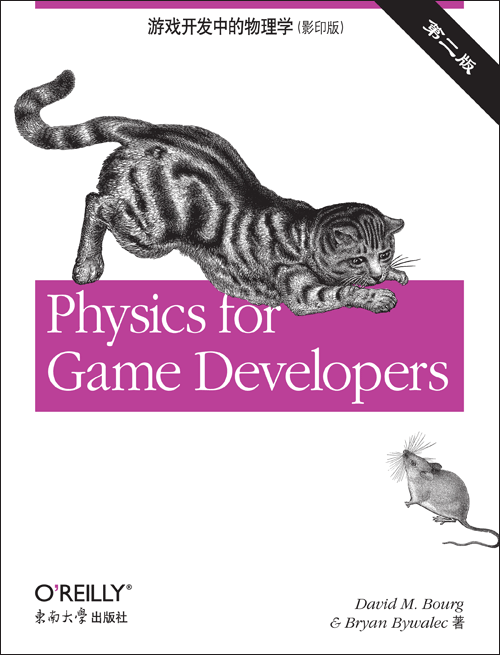游戏开发中的物理学(第二版,影印版)
出版时间:2013年12月
页数:551
“《游戏开发中的物理学》包含了大量针对现实世界物理问题的解决方法,而这些方法可以被马上用到游戏代码中去。”
——Paul Zirkle
迪斯尼互动公司的
首席游戏工程师
如果你打算丰富游戏中现实意义上的物理体验,这本经典书籍的扩展版本可以为你细化游戏开发中的物理规则。你将学到碰撞、爆炸、声音、弹射和其他一些在Wii、PlayStation、Xbox、智能手机和平板电脑中使用的效果。你也将了解如何利用诸如加速计和光学跟踪设备这样的传感器。
通过所提供的技术背景、公式和一些示例代码,作者David Bourg和Bryan Bywalec为你展示了如何开发适合于多种问题的属于你自己的方案。无论你是孤军奋战还是团队协作,本修订本都是不可或缺的。
· 刷新你对于经典力学的知识,包括运动学、力学、动力学和碰撞响应
· 探索刚体动力学,使用实时2D和3D模拟来处理旋转和惯性
· 解决实际问题:为帆船、飞机、汽车和运动球建模
· 通过数字物理学增强游戏,使用加速计、触摸屏、GPS、光学跟踪设备和3D显示器
· 使用OpenAL音频API捕捉3D声效
David Bourg是MiNO Marine公司的拥有者,这是一家从事造船工程和海事服务的公司。他还在20世纪90年代创办了一家开发儿童游戏、赌博游戏和多种PC到Mac接口的公司。他是《游戏开发中的人工智能》(O’Reilly出版社)一书的作者之一。
Bryan Bywalec是MiNO Marine公司的架构师,在那里对物理世界的精确模拟是日常工作所必需的。他对物理充满激情,他喜欢修改那些让物理担当主角的游戏(比如《Kerble Space Program》)。
——Paul Zirkle
迪斯尼互动公司的
首席游戏工程师
如果你打算丰富游戏中现实意义上的物理体验,这本经典书籍的扩展版本可以为你细化游戏开发中的物理规则。你将学到碰撞、爆炸、声音、弹射和其他一些在Wii、PlayStation、Xbox、智能手机和平板电脑中使用的效果。你也将了解如何利用诸如加速计和光学跟踪设备这样的传感器。
通过所提供的技术背景、公式和一些示例代码,作者David Bourg和Bryan Bywalec为你展示了如何开发适合于多种问题的属于你自己的方案。无论你是孤军奋战还是团队协作,本修订本都是不可或缺的。
· 刷新你对于经典力学的知识,包括运动学、力学、动力学和碰撞响应
· 探索刚体动力学,使用实时2D和3D模拟来处理旋转和惯性
· 解决实际问题:为帆船、飞机、汽车和运动球建模
· 通过数字物理学增强游戏,使用加速计、触摸屏、GPS、光学跟踪设备和3D显示器
· 使用OpenAL音频API捕捉3D声效
David Bourg是MiNO Marine公司的拥有者,这是一家从事造船工程和海事服务的公司。他还在20世纪90年代创办了一家开发儿童游戏、赌博游戏和多种PC到Mac接口的公司。他是《游戏开发中的人工智能》(O’Reilly出版社)一书的作者之一。
Bryan Bywalec是MiNO Marine公司的架构师,在那里对物理世界的精确模拟是日常工作所必需的。他对物理充满激情,他喜欢修改那些让物理担当主角的游戏(比如《Kerble Space Program》)。
- Chapter 1: Basic Concepts
- Newton’s Laws of Motion
- Units and Measures
- Coordinate System
- Vectors
- Derivatives and Integrals
- Mass, Center of Mass, and Moment of Inertia
- Newton’s Second Law of Motion
- Inertia Tensor
- Relativistic Time
- Chapter 2: Kinematics
- Velocity and Acceleration
- Constant Acceleration
- Nonconstant Acceleration
- 2D Particle Kinematics
- 3D Particle Kinematics
- Kinematic Particle Explosion
- Rigid-Body Kinematics
- Local Coordinate Axes
- Angular Velocity and Acceleration
- Chapter 3: Force
- Forces
- Force Fields
- Friction
- Fluid Dynamic Drag
- Pressure
- Buoyancy
- Springs and Dampers
- Force and Torque
- Summary
- Chapter 4: Kinetics
- Particle Kinetics in 2D
- Particle Kinetics in 3D
- Rigid-Body Kinetics
- Chapter 5 Collisions
- Impulse-Momentum Principle
- Impact
- Linear and Angular Impulse
- Friction
- Chapter 6: Projectiles
- Simple Trajectories
- Drag
- Magnus Effect
- Variable Mass
- Rigid-Body Dynamics
- Chapter 7: Real-Time Simulations
- Integrating the Equations of Motion
- Euler’s Method
- Better Methods
- Summary
- Chapter 8: Particles
- Simple Particle Model
- The Basic Simulator
- Implementing External Forces
- Implementing Collisions
- Tuning
- Chapter 9: 2D Rigid-Body Simulator
- Model
- The Basic Simulator
- Tuning
- Chapter 10: Implementing Collision Response
- Linear Collision Response
- Angular Effects
- Chapter 11 Rotation in 3D Rigid-Body Simulators
- Rotation Matrices
- Quaternions
- Quaternions in 3D Simulators
- Chapter 12: 3D Rigid-Body Simulator
- Model
- Integration
- Flight Controls
- Chapter 13: Connecting Objects
- Springs and Dampers
- Connecting Particles
- Connecting Rigid Bodies
- Chapter 14: Physics Engines
- Building Your Own Physics Engine
- Physical Modeling
- Chapter 15: Aircraft
- Geometry
- Lift and Drag
- Other Forces
- Control
- Modeling
- Chapter 16: Ships and Boats
- Stability and Sinking
- Ship Motions
- Resistance and Propulsion
- Maneuverability
- Chapter 17: Cars and Hovercraft
- Cars
- Hovercraft
- Chapter 18: Guns and Explosions
- Projectile Motion
- Taking Aim
- Recoil and Impact
- Explosions
- Chapter 19: Sports
- Modeling a Golf Swing
- Billiards
- Digital Physics
- Chapter 20: Touch Screens
- Types of Touch Screens
- Step-by-Step Physics
- Example Program
- Other Considerations
- Chapter 21: Accelerometers
- Accelerometer Theory
- Sensing Orientation
- Sensing Tilt
- Chapter 22: Gaming from One Place to Another
- Location-Based Gaming
- What Time Is It?
- Location, Location, Location
- Chapter 23: Pressure Sensors and Load Cells
- Under Pressure
- Button Mashing
- Barometers
- Chapter 24: 3D Display
- Binocular Vision
- Stereoscopic Basics
- Types of Display
- Programming Considerations
- Chapter 25: Optical Tracking
- Sensors and SDKs
- Numerical Differentiation
- Chapter 26: Sound
- What Is Sound?
- Characteristics of and Behavior of Sound Waves
- 3D Sound
- Appendix Vector Operations
- Vector Class
- Vector Functions and Operators
- Appendix Matrix Operations
- Matrix3×3 Class
- Matrix Functions and Operators
- Appendix Quaternion Operations
- Quaternion Class
- Quaternion Functions and Operators
- Appendix Bibliography
- General Physics and Dynamics
- Mathematics and Numerical Methods
- Computational Geometry
- Projectiles
- Sports Ball Physics
- Aerodynamics
- Hydrostatics and Hydrodynamics
- Automobile Physics
- Real-time Physics Simulations
- Digital Physics
书名:游戏开发中的物理学(第二版,影印版)
作者:David M. Bourg, Bryan Bywalec 著
国内出版社:东南大学出版社
出版时间:2013年12月
页数:551
书号:978-7-5641-4599-6
原版书书名:Physics for Game Developers, 2nd Edition
原版书出版商:O'Reilly Media
The animals on the cover of Physics for Game Developers, 2nd Edition are a cat and amouse. The age-old rivalry between cat and mouse has been the topic of many children’sbooks and Saturday cartoons. From traditional folk tales, such as Aesop’s fables andGrimm Brothers’ fairy tales, to today’s cartoons, such as Tom & Jerry , the cat has chasedand bullied the mouse and the mouse has avoided becoming lunch. The cat may bebigger and stronger, but the mouse is small, fast, and can fit in tight spaces, so the endresult is often a battle of wits.The cover image is from a 19-century engraving from the Dover Pictorial Archive. Thecover font is Adobe ITC Garamond. The text font is Adobe Minion Pro; the headingfont is Adobe Myriad Condensed; and the code font is Dalton Maag’s Ubuntu Mono.
购买选项
